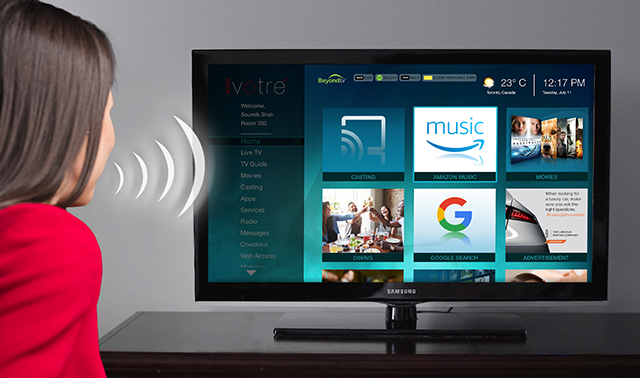Smart speakers are becoming a more common platform for controlling connected entertainment due to a rapid increase in popularity and ease of use. New entrants in the connected consumer electronics market, including Samsung, Roku and Facebook, are likely to make announcements about new voice-controlled speakers at CES 2019 in order to claim a share of this new voice-first CE market. The average U.S. broadband household in 2018 had 8.8 connected computing, entertainment, or mobile devices, all with unique user controls or interfaces. Audio Visual Installer in Long Island NY
Voice innovation is developing as an answer for this multifaceted nature, offering a solitary interface for every single associated gadget. Buyers have communicated a solid enthusiasm for this methodology, with more than 33% of U.S. broadband family units thinking that its speaking to utilize voice to control their stimulation devices.However, notwithstanding voice-controlled amusement’s preferences for looking and gushing substance, purchaser appropriation stays low, with just 3 percent of U.S. broadband family units utilizing voice directions when watching video.
Interoperability Demands
Use of voice-controlled search is held back due to limited product availability, inexperience or lack of familiarity with the technology, or simply old consumer habits. Consumers increasingly are becoming familiar with using voice commands to operate their smartphones, though. Last year, nearly 40 percent of U.S. broadband households with a smartphone used some form of voice recognition software. It therefore is likely that consumers will become more interested in using voice commands to control other common consumer devices, including connected entertainment systems.Audio Visual Installer in Long Island NY
The consumer electronics industry is weathering a rough spot as cellphones, tablets and flat-panel TVs hit saturation levels. Newer product categories, such as wireless speakers, are eliminating the need for more conventional electronic devices. Furthermore, the growing popularity of streaming digital media and the pervasiveness of  smartphones are driving entire product categories — such as camcorders, MP3 players and GPS navigators — into obsolescence.
smartphones are driving entire product categories — such as camcorders, MP3 players and GPS navigators — into obsolescence.
Faced with stagnating sales growth, the industry has been turning to categories such as wireless speakers and smart TVs as drivers of future growth. Rapid advancements in voice technology enable wireless speakers to become smart speakers, and smart TVs to assume a wider role in the CE ecosystem.
Manufacturers of other CE products, such as streaming media players, have expanded their product portfolios with new voice-enabled models to claim their share of a quickly growing voice-controlled entertainment market.
Consumer adoption of voice-controlled CE devices places new interoperability demands on product manufacturers. Ideally, all consumer-purchased products would work perfectly with each other. However, the reality of this level of interoperability remains elusive, with about 10 percent of consumers returning a CE device citing interoperability as the reason for the return.
Issues ranging from high-end stereo speakers not being recognized by smart assistants to smart TVs failing to accurately understand voice commands from a shared smart speaker are all too common.Audio Visual Installer in Long Island NY
Voice-AI systems remain weak in the contextual awareness required to properly respond based on which device the consumer is using, where the user is, what time it is, etc. These variables may require different responses from the virtual assistant; however, typical existing systems fail to account for them.
Increasing the number of variables also increases ambiguity levels, which AI systems struggle to address. Device vendors must build greater awareness levels into their systems in order for them to deliver more accurate responses to user questions, or risk losing their customers to a more capable voice-AI system.
Voice vs. Remote
As the number of connected entertainment devices per household increases, so do the number of remotes. Despite the desire for a standardized user interface for all their CE devices, consumer familiarity with handheld remotes make them the de facto standard for controlling a CE device.
Just as the TV remote liberated the viewer from the laborious process of physically moving to the television set every time they wanted to make an adjustment, voice control is freeing consumers from the cumbersome process of manually thumbing a remote to search through a channel guide or key in a title on an alphabetic keypad on screen to locate content.
Voice interfaces simplify the experience by utilizing the user’s verbal commands to make adjustments, change the volume, etc. A person wishing to view the news need only say “CNN” to be directed to that channel. Voice command also presents a simple means of deeply searching a library. Commands such as “find all free Tom Hanks adventure movies” would be difficult and slow to enter on a manual remote, but effortless via voice.Audio Visual Installer in Long Island NY
That being said, device makers will continue to make manual remotes available in order to please customers who want manual control, and in the event that voice-based functionality is unavailable or ineffective. Incorporating voice into the remote may incentivize consumers to try voice, but until users see a benefit to using voice, many will simply default to manual control.
The consumer movement to voice-controlled entertainment is still in its early stages; however, interest in these applications is quickly growing and impacting purchasing decisions. Companies wishing to capitalize on this growing market need to carefully develop their market strategies and plan for both short- and long-term success.
Success will be dependent not only on a product’s design and quality, but also on its ability to provide a more satisfying user experience than a consumer already can enjoy using traditional control methods.
